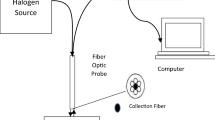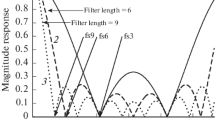Abstract
A novel chemometric method, region orthogonal signal correction (ROSC), is proposed and applied to pretreat near-infrared (NIR) spectra of blood glucose measured in vivo. Water is the most serious interference component in such kinds of noninvasive measurements, because it shows very high absorbance in the spectra. In the present study, the spectra of blood glucose in the range of 1212–1889 nm are used, in which the absorption of water around 1440 nm is very high. ROSC aims at removing the interference signal due to water from the spectra by selecting a set of spectra with a special region of 1404–1454 nm that mainly contain information about the variation of the interference component, water, and calculating the orthogonal components to the concentrations of glucose that will be removed. The difference between ROSC and orthogonal signal correction (OSC) is that ROSC uses a special region of spectra for the estimation of scores and loading weights of orthogonal components to pretreat the spectra in other regions, while OSC only uses one fixed region of spectra to calculate loadings, scores and weights of OSC components and removes the OSC components in the same region. A clear advantage of ROSC is that it is more interpretable than OSC, because one can select a spectral region to remove the variation of a special component such as water. Another chemometric method, moving window partial least squares (MWPLSR), is also used to select informative regions of glucose from the NIR spectra of blood glucose measured in vivo, leading to improved PLS models. Results of the application of ROSC demonstrate that ROSC-pretreated spectra including the whole spectral region of 1212–1889 nm or an informative region of 1600–1730 nm selected by MWPLSR provide very good performance of the PLS models. Especially, the later region yields a model with RMSECV of 15.8911 mg/dL for four PLS components. ROSC is a potential chemometric technique in the pretreatment of various spectra.
Similar content being viewed by others
References
R. Marbach, T. Koschinsky, F. A. Gries, and H. M. Heise, Appl. Spectrosc., 1993, 47, 875.
J. J. Burmeister and M. A. Arnold, Clin. Chem., 1999, 45, 1621.
M. A. Arnold and G. W. Small, Anal. Chem., 1990, 62, 1457.
A. Samann, Ch. Fishbacher, K. U. Jagemann, K. Danzer, J. Schuler, L. Papenkordt, and U. A. Muller, Exp. Clin. Endocrinol. Diabetes, 2000, 108, 406.
M. R. Robinson, R. P. Eaton, D. M. Haaland, G. W. Koepp, E. V. Thomas, B. R. Stallard, and P. L. Robinson, Clin. Chem., 1992, 38, 1618.
H. M. Heise, A. Bittner, and R. J. Marbach, Near Infrared Spectrosc., 1998, 6, 349.
H. M. Heise, R. Marbach, T. H. Koschinsky, and F. A. Gries, Artif. Org., 1994, 18, 439.
R. Marbach and H. M. Heise, Appl. Optics, 1995, 34, 610.
K. U. Jagemann, C. Fischbacher, K. Danzer, U. A. Muller, and B. Mertes, Z. Phys. Chem., 1995, 191S, 179.
C. Fischbacher, K. U. Jagemann, K. Danzer, U. A. Muller, L. Papenkrodt, and J. Schuler, Fresenius J. Anal. Chem., 1997, 359, 78.
K. Maruo, M. Tsurugi, M. Tamura, and Y. Ozaki, Appl. Spectrosc., 2003, 57, 1236.
K. Maruo, M. Tsurugi, J. Chin, T. Ota, H. Arimoto, Y. Yamada, M. Tamura, M. Ishii, and Y. Ozaki, IEEE J. Sel. Top. Quantum Electron., 2003, 9, 322.
G. Yoon, A. K. Amerov, K. J. Jeon, and Y. J. Kim, Appl. Optics, 2002, 41, 1469.
S. Wold, H. Antti, F. Lindgren, and J. Ohman, Chemom. Intell. Lab. Syst., 1998, 44, 175.
J. Sjoblom, O. Svensson, M. Josefson, H. Kullberg, and S. Wold, Chemom. Intell. Lab. Syst., 1998, 44, 229.
T. Fearn, Chemom. Intell. Lab. Syst., 2000, 50, 47.
B. M. Wise and N. B. Gallagher, http://www.eigenvector.com/MATLAB/OSC.html.
J. H. Jiang, R. J. Berry, H. W. Siesler, and Y. Ozaki, Anal. Chem., 2002, 74, 3555.
J. A. Westerhuis, S. Jong, and A. K. Smilde, Chemom. Intell. Lab. Syst., 2001, 56, 13.
S. Kasemsumran, Y. P. Du, K. Murayama, M. Huehne, and Y. Ozaki, Analyst, 2003, 128, 1471.
Y. P. Du, Y. Z. Liang, J. H. Jiang, R. J. Berry, and Y. Ozaki, Anal. Chim. Acta, 2003, 501, 183.
Author information
Authors and Affiliations
Rights and permissions
About this article
Cite this article
Du, Y.P., Liang, Y.Z., Kasemsumran, S. et al. Removal of Interference Signals Due to Water from in vivo Near-Infrared (NIR) Spectra of Blood Glucose by Region Orthogonal Signal Correction (ROSC). ANAL. SCI. 20, 1339–1345 (2004). https://doi.org/10.2116/analsci.20.1339
Received:
Accepted:
Published:
Issue Date:
DOI: https://doi.org/10.2116/analsci.20.1339




